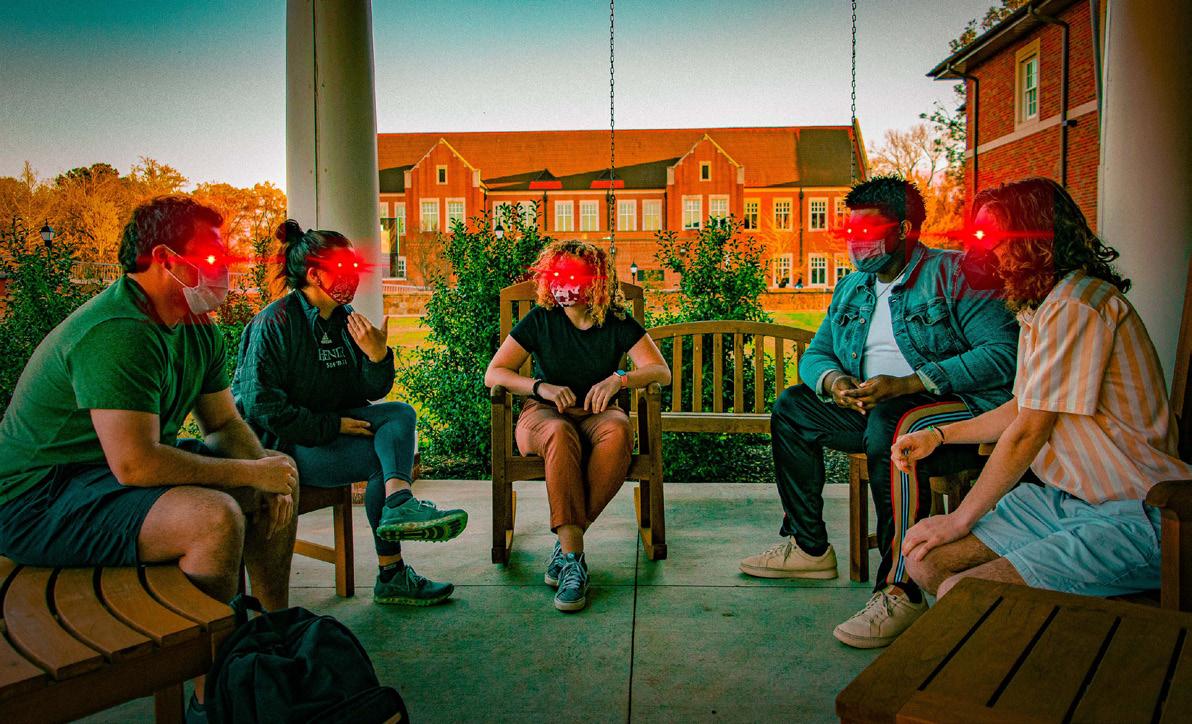
7 minute read
Catnapped
from The Fool-Proof Issue
by The Profile
Tad has disappeared for the second time this year
Whether he has been catnapped or gotten lost somewhere around Conway, Tad has gone missing for the second time this school year. If you are new to the Hendrix community, Tad is one of the most popular cats that lives in Hendrix’s cat colony. He is a treat-loving, friendly, Cheeto-orange, chunky boy that has even been deemed the “Mayor of Hendrix.” On an afternoon at the beginning March, Tad did not show up for dinner. If you know literally anything about this cat, it is probably that he is obsessed with food. The only time I have personally seen him pass up dinner was when he returned to campus after his first catnapping. This was only because all of the people on campus were so ecstatic to see him back that they bombarded him with so many treats that he physically could not fit his dinner in his belly. This being said, the Hendrix cat lovers were immediately suspicious about his whereabouts when we all heard he was not present for dinner. Unfortunately, it has been over a month, and we have still not heard any news about where Tad is now.
Advertisement
For those of us who adore Tad and all of the other campus cats, the lack of Tad on campus feels like there is a part of the Hendrix spirit missing. It almost seems silly to say that losing Tad feels like an emotional hole in the hearts of many of us, but he is a big part of our lives—just like any other pet would be. It is even harder to comprehend this time around because we have no idea or closure as to what has happened to him. There was no note and no trace of him, and he just “vanished like Amelia Earhart,” to put it in the words of a fellow Hendrix student. Although this abrupt time of Tad being missing has been difficult for Hendrix students and faculty, it has perhaps been worse for one of the other campus cats, Tadpole. As his name suggests, it is believed that he is Tad’s son. This being said, Tad and Tadpole are the best of pals; they often even sleep together during the night. Now that Tad is gone, many students have reported hearing Tadpole crying out of loneliness. If pushing a cat to a state of melancholy is not a motivation to make you want to find Tad, I am not sure what else would be.
It also needs to be reestablished that there is no reason that any of the cats should be removed from campus. This is their home, and I know for certain that Darryl Manes, the primary caretaker of the Hendrix Cat Colony, will always want the best for the campus cats. His efforts often go unnoticed, but he does a truly fantastic job ensuring that the cats are all healthy and happy. I can personally testify that the cats are taken care of just as well as (perhaps even better than) anyone’s pet cat. Tad and the other cats actively choose to stay at Hendrix, and this is the place they know as home. Even when Darryl took Tad to his home off campus for two days during the snowstorm this winter, he said Tad cried the whole time. He is not meant to be confined inside a house, and it is easy to tell that he genuinely enjoys living at Hendrix. His days are filled with basking in the sun, getting tons of pets from all of his student human friends, and a multitude of treats to accompany his wet and dry food. All of this being said, anyone who is close to the cats can testify that they live their lives however they enjoy. And for Tad, this means drowning himself in a sea of treats and attention.
Maybe someone has accidentally taken Tad again or perhaps he has merely gotten lost in the roundabouts of Conway, but either way, please contact Darryl Manes at manes@hendrix.edu if you have seen Tad anywhere or have any ideas of where he may be. If you or someone you know has taken Tad, we ask that you please return him. There would be no hard feelings or repercussions if someone decides to willingly bring him back to campus. Tad is a part of our Hendrix family, and things simply do not feel the same without him.
Photo by Rebecca Burks
POETRY: TURNING NATURE AND IDEAS INTO ART
The first time I remember writing poetry was on the playground in elementary school, making up rhyming chants with my friends or scribbling down haikus about my cat. The way that words could be rearranged and melded to conjure up images or emotions always used to fascinate me. These days, not much has changed. There isn’t usually a specific end result in mind whenever I begin to write a poem. I’ll start with an idea, which can consist of a particular image, vague memory or feeling, or even just a word I like the sound of. The last page of my notebooks usually contain a few scribbled words I heard during class, and the notes app on my phone is filled with lists of words and phrases that I think of during my everyday life. It’s a bit of a chaotic system, but I’ll often go hunting through my notes to find inspiration for a poem. From there, I start to write, usually deciding on line breaks and stanzas as I go (and then changing them around a few dozen times while editing). It isn’t unusual for a poem to ‘get away’ from me and end up very different than how I had expected -- for better or for worse! Often a poem won’t go the way I want it to, so I’ll end up abandoning it and starting again, sometimes with a slightly different idea in mind. The subject matter of my poems is often nature-based, and usually includes nature imagery even if this isn’t the main focus. In my opinion, poetry has the ability to make readers pause and consider a topic, object, or instance closer and more deeply than they normally would. The freedom of language and form that is available in a free verse poem allows for seemingly mundane things to seem like something more. I enjoy trying to find different ways to make small and mundane subjects seem extraordinary, as well as taking topics with generally negative association, such as death or darkness, and attempting to convey the odd, melancholic beauty that can be found in undesirable concepts. For a long time I only wrote in free verse and thought that strict poetic forms were constraining and stifling. Once I learned more about different styles of poetry, however, it became apparent that there are some subjects that lend themselves better to the sonnet or the villanelle, and could not quite be captured in free verse. I tend to lean towards more descriptive poetry rather than narrative, although I have been trying to expand my writing to different styles, themes, and subject matter. I have always enjoyed writing descriptions and imagery, especially when it can be done in an interesting or unexpected way. Many of the frequently used similes and metaphors are so fitting that it can be difficult to find less overused ways to phrase descriptions. I often struggle with finding the balance between cliche explanations and comparisons that are a bit too far reaching or don’t quite make sense. There have been countless times when a relationship between images seems perfectly clear in my head, but doesn’t quite translate onto paper. I have a document containing a messy list of snippets and descriptions that didn’t work, but I was too attached to delete entirely. Every once in a while I’m able to salvage a line or phrase, but the majority of these poem bits are collecting dust. My enjoyment of words and poetry has only grown since those days on the playground. I hope to continue learning how to further develop and improve my work, and also be able to share my poetry with a wider audience.
Note from the Editor: The following poem “remains” by featured poet Flannery Hirrel won the Poets’ Roundtable of Arkansas’ Jeanie Dolan Carter Memorial Collegiate Contest. In addition, student Annemarie Bennett also won third prize in the contest and student Zoie Keys received an honorable mention.
remains
the creature died a while ago, flesh picked over by vultures and then maggots until only the gleam of bone remained. polished clean by the rain, bleached white by the sun. only the bare scaffolding of the creature it used to be — the ribs curving upwards in glowing crescents, the skull a hollow cup to collect the morning dew. a frosted spiderweb spans the ribcage, an arachnid peering out from between the pale arches, daring passing insects to join her in the ring. she waits in her mausoleum, not knowing that she isn’t the first to breathe within this ribcage, that she is allowing these bones to once again house a life








